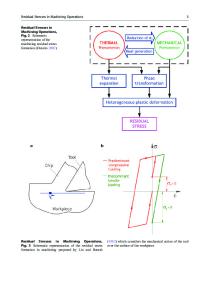Effects of the metal workpiece properties on the residual stresses in silicon nitride-metal brazed joints
- PDF / 303,649 Bytes
- 9 Pages / 612 x 792 pts (letter) Page_size
- 112 Downloads / 450 Views
MATERIALS RESEARCH
Welcome
Comments
Help
Effects of the metal workpiece properties on the residual stresses in silicon nitride-metal brazed joints Pascal J. Yvon,a) Benoit Marty,b) and Stathis D. Peteves Institute for Advanced Materials, JRC, Commission of the European Communities, 1755 ZG Petten, The Netherlands (Received 24 August 1995; accepted 18 March 1996)
Modelling, but more importantly, measurements of residual stresses are needed to guide the design and development of high integrity ceramic/metal joints. This study evaluates the influence of the metal workpiece on the residual stress state present in the ceramic part of the joint. Si3 N4 was directly bonded via the active metal brazing route to several metals Cu, Mo, W, Ta, Nb, Zr, Ti, and AISI 316, selected to cover an extended range of thermomechanical properties. The residual strains in the joints were measured using an x-ray diffraction technique. The results indicate that the maximum residual stresses scale with the thermal mismatch for metals with low coefficients of thermal expansion. The experimental results are compared with analytical calculations of the residual stresses.
I. INTRODUCTION
Ceramics possess a wide range of properties and characteristics that make them attractive for a variety of advanced technology applications. Si3 N4 ceramics, for example, because of their excellent high temperature mechanical properties, wear, and corrosion resistance, are suitable for components in engines, heat exchangers, and wear parts. However, effective and widespread use of Si3 N4 in these and other applications often requires it to be functionally or structurally interfaced with metallic structures. Hence, joining technologies are crucial to the exploitation of these new ceramics. Joining of ceramics to metals is inherently difficult because of their distinctly different properties, but considerable efforts devoted to the development of joining technologies in recent years have led to significant successes. A number of techniques can be used in principle to join Si3 N4 ceramics.1 One of the most favored is active brazing, due to its flexibility, cost-effectiveness, and the fact that it can yield high strength joints.2 Not surprisingly, however, upon direct brazing of Si3 N4 to metallic materials, residual stresses develop during cooling from the brazing temperatures which are usually in excess of 600 ±C. The level and complexity of the residual stress state that builds up in the joint assembly depend on several factors but most notably on (i) the difference between the brazing and ambient temperature, (ii) the
a)
Present address: CEREM/SRMA CEA Saclay, 91191 Gif sur Yvette, France. b) Present address: LM3, ENSAM, 151 Boulevard de l’Hˆopital, 75013 Paris, France. 3090
http://journals.cambridge.org
J. Mater. Res., Vol. 11, No. 12, Dec 1996
Downloaded: 13 Mar 2015
thermal contraction mismatch between the bonded materials, (iii) the size and shape of the joint workpieces, and (iv) the ability of the metal to plastically deform and hence absorb s
Data Loading...










